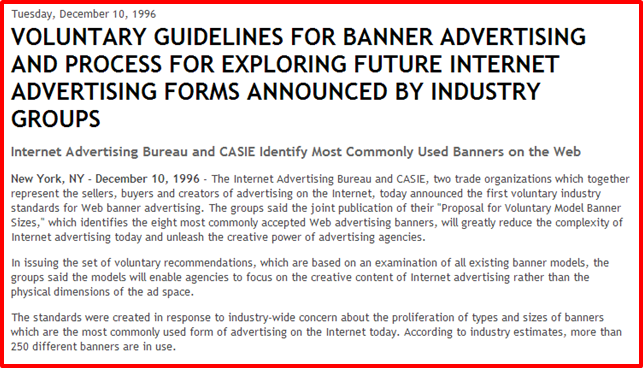Geeking Out On Digital Ads: A Definitive History Of IAB Standards
We've come a long way in the last 18 years! See how digital ad formats have evolved over time. Avoid the perils of the past and forge the future.
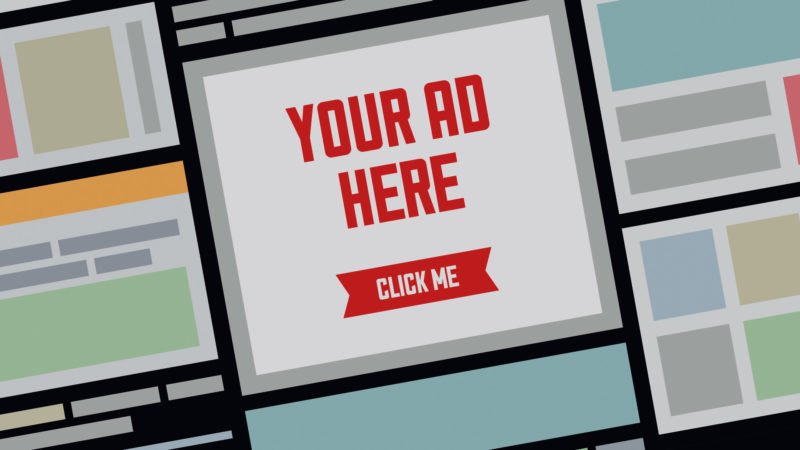 I love standard ad formats, I confess. I find myself daydreaming about them when I am in meetings. My scratch pads are filled with ad standard doodles. I corner people at parties expounding on the sublime qualities of the Medium Rectangle; I mean, who doesn’t marvel at the fact that this desktop unit fits neatly in-stream on smartphones, yet it was named a standard a full five years before the iPhone was introduced? Cool, right?
I love standard ad formats, I confess. I find myself daydreaming about them when I am in meetings. My scratch pads are filled with ad standard doodles. I corner people at parties expounding on the sublime qualities of the Medium Rectangle; I mean, who doesn’t marvel at the fact that this desktop unit fits neatly in-stream on smartphones, yet it was named a standard a full five years before the iPhone was introduced? Cool, right?

The Author Sadly Geeking Out on Ad Standards
The astute reader may not be surprised to hear that I collected match book covers in my youth. I would spend hours studying the wonderful designs and marvel at the extent to which talented creators could communicate so much in a judicious little package. In addition to feeding my inner geek, however, I love standard ad formats because they enable the scale required by brand marketers today. It’s a simple tradeoff that no one has been able to cheat — the more custom an ad program, the more expensive it is and the less scale it is able to achieve for a given amount of resources. Perhaps even more important than enabling scale, I love that ad standards are the carriers of great creative executions like the one for the iPad Air below, which used the IAB Billboard. And here I see another very simple equation: the better the ad standards, the better the creative. My true commercial passion for ad standards stems from this fundamental belief. 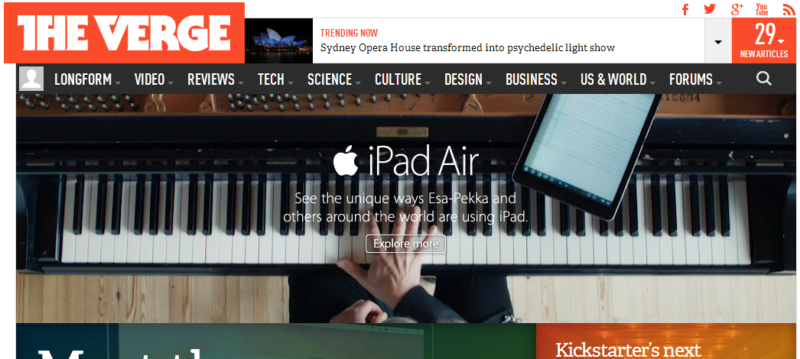 More so than an ad format geek, I am a true believer in the power of creative ideas to transform businesses and transfix consumers. To reach people today, these great creative ideas must be carried in great ad standards. As described here before, the industry is working hard to improve the quality of its standards, and I lead a series of initiatives at the Interactive Advertising Bureau (IAB) to do this. It occurred to me as part of this process that to effectively move the industry forward, we must have a clear understanding of where we came from. In this light, I spent a blissful day reconstructing the history of industry ad standards, which I lay before you here. To my fellow digital ad geeks: you’re welcome. To the less-enamored reader: gaining an understanding of the foundation of today’s ad standard universe will help you avoid the errors of the past and lead the future.
More so than an ad format geek, I am a true believer in the power of creative ideas to transform businesses and transfix consumers. To reach people today, these great creative ideas must be carried in great ad standards. As described here before, the industry is working hard to improve the quality of its standards, and I lead a series of initiatives at the Interactive Advertising Bureau (IAB) to do this. It occurred to me as part of this process that to effectively move the industry forward, we must have a clear understanding of where we came from. In this light, I spent a blissful day reconstructing the history of industry ad standards, which I lay before you here. To my fellow digital ad geeks: you’re welcome. To the less-enamored reader: gaining an understanding of the foundation of today’s ad standard universe will help you avoid the errors of the past and lead the future.
IAB Display Standards: 18 Years in the Making
With the pithy headline displayed in the accompanying visual, the IAB (then the Internet Advertising Bureau), together with CASIE (with which it later merged), birthed not one, but eight initial ad standards in 1996.
The next fruitful period of innovation occurred in 2002–2004, when eleven new standards were added to the portfolio. Famously, these included the Universal Ad Package, announced in 2002; infamously, these also included pop-up and pop-under, which climbed aboard in 2004. Happily, these latter standards were later sunset. During this period, the IAB began the process of supplementing its standard ad formats with additional market guidance in the form of Guidelines, a practice which remains in effect today. The Rich Media Guidelines announced during this period pioneered this practice. The third and final historical period of innovation in the display category occurred during 2012 and 2013 when the Display Rising Stars were added to the portfolio, together with the Super Leaderboard. Prior to the start of the Rising Stars program, 11 legacy units were delisted. During this time, the Rich Media Guidelines were updated, while a third form of market guidance, an IAB Protocol (SafeFrame 1.0), was added. A protocol is a technical specification that standardizes communication between the ad creative and the systems that host the content. Protocols have become increasingly important tools and will be a critical component in tackling the cross-screen challenge. Today, the IAB display ad product portfolio includes 14 standards, Rich Media Guidelines, and the SafeFrame 1.0 Protocol. 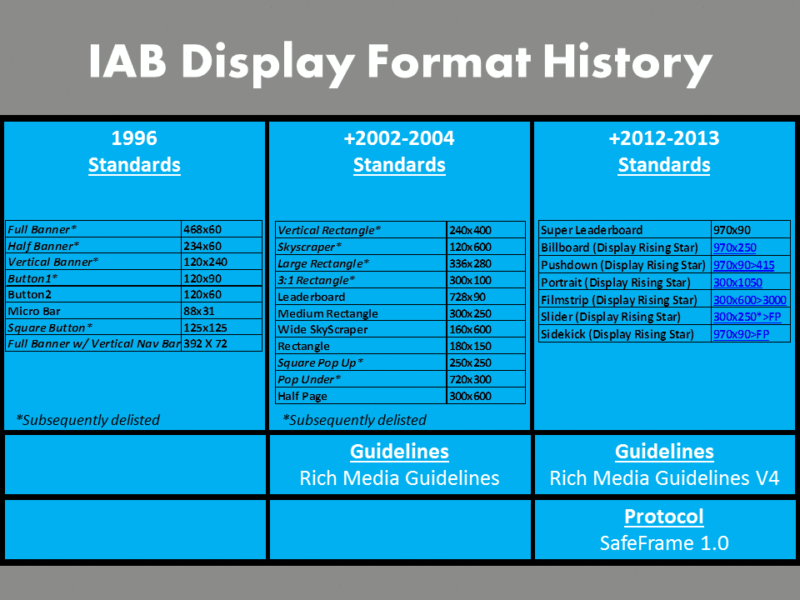
IAB Digital Video Standards: The Backstory
The industry took a slightly different approach to establishing the direction of digital video advertising, starting in 2008 and 2009.
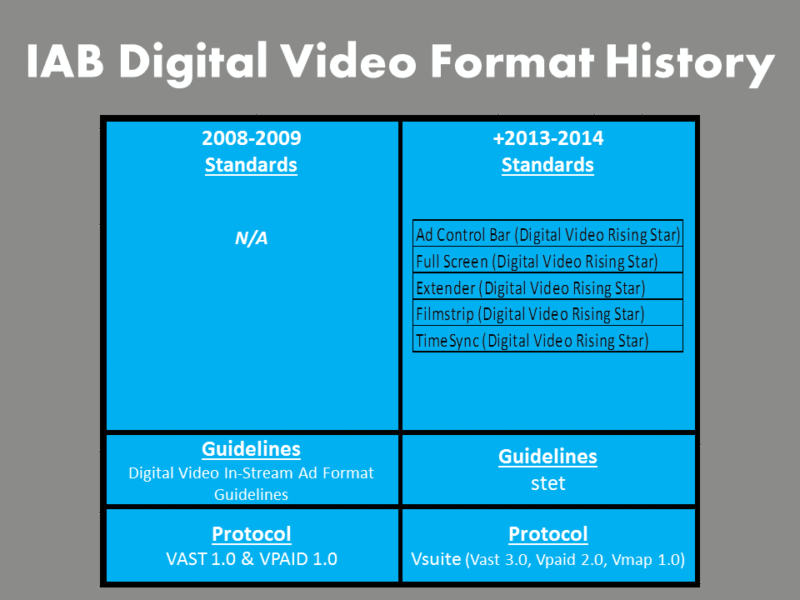
During that time period, guidelines and protocols were first established, specifically with the Digital Video In-Stream Ad Format Guidelines and VAST 1.0/VPAID 1.0 protocols. Ad standards came later in 2013–2014 with the Digital Video Rising Stars, while the protocols were updated considerably and consolidated into a single VSuite.
IAB Mobile Standards: The Most Recent History
The industry began setting direction in mobile with the establishment of the MRAID Protocol in 2011, perhaps signaling an evolution in the approach to ad product development.
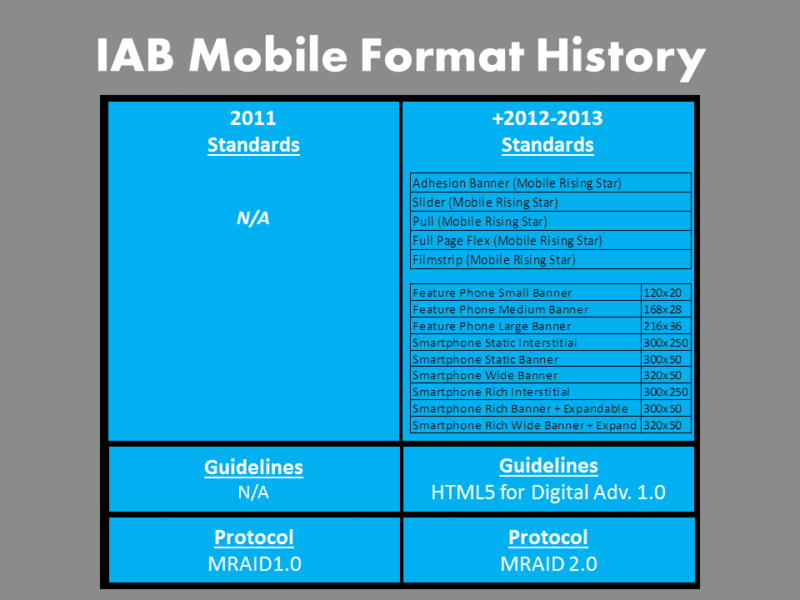
This was followed up in 2012–2013 with the adoption of the Mobile Rising Stars, while the IAB also endorsed the legacy MMA Mobile Phone Creative banners during this period.
The Big Picture
Today, the IAB has 33 creative standards across display, mobile, and digital video, as well as guidelines and protocols for each category.
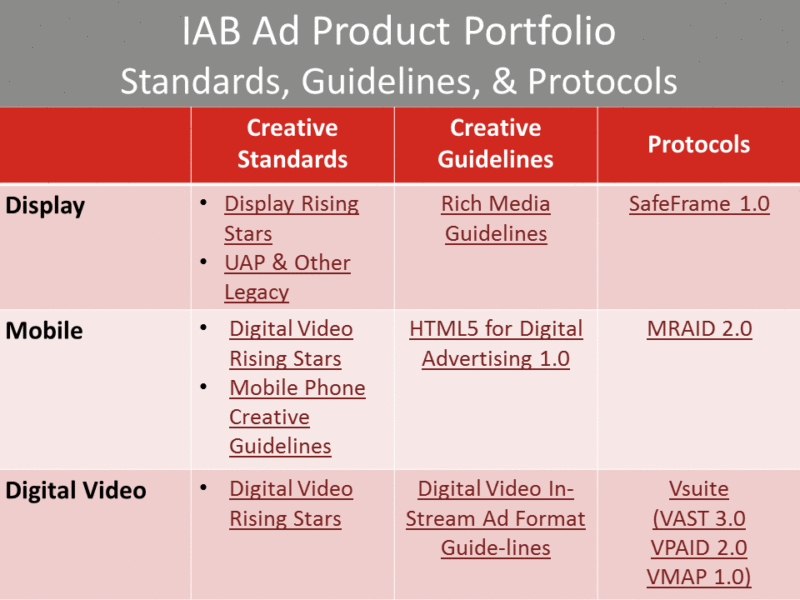
To The Future Of Digital Creative…
When I look at this body of work, my inner geek rejoices at the rich ad products and tools available. What I don’t see, however, are pixel dimensions and code; rather, I envision great creative ideas coming to life.
I also marvel at the enormous amount of collaborative work from publishers, marketers, agencies and technology companies that it represents — and am grateful that each recognizes that this really is just the beginning, a foundation for developing the next generation of ad products that will enable the long-promised digital creative revolution.
Contributing authors are invited to create content for MarTech and are chosen for their expertise and contribution to the search community. Our contributors work under the oversight of the editorial staff and contributions are checked for quality and relevance to our readers. MarTech is owned by Semrush. Contributor was not asked to make any direct or indirect mentions of Semrush. The opinions they express are their own.
Related stories
